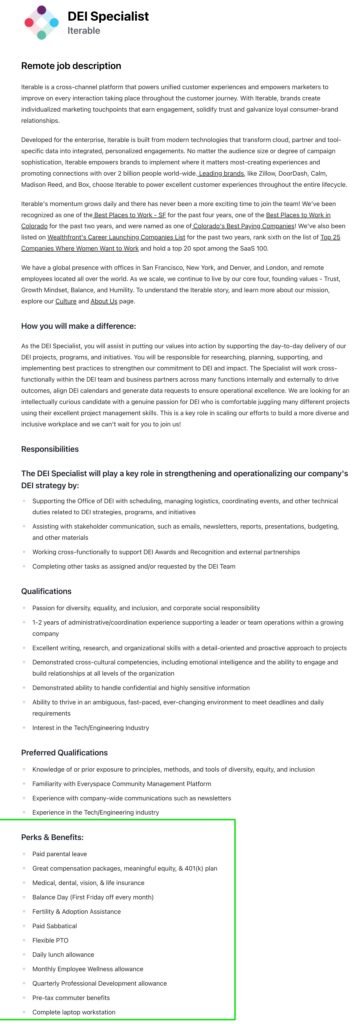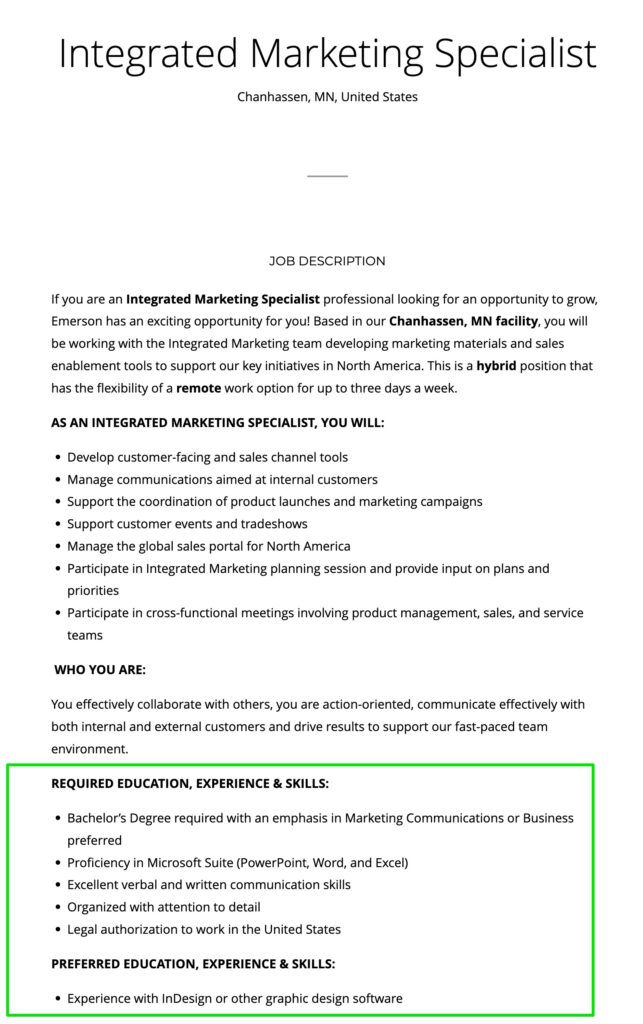- How to Use Microsoft Word’s Readability Feature: 3 Easy Tips - March 14, 2025
- 3 Free Job Description Templates for Google Docs - February 27, 2025
- 10+ Free Job Description Template for Word Examples - January 15, 2025
A high apply rate doesn’t always translate into a diverse talent pool. If this sounds like your company, you might need to tweak your job ads (and where you post them).
Here are 5 tips on writing job ads to attract diverse talent.
1. Eliminate bias from your job ads
Writing job ads with bias can cause your company to lose 39% of your job applicants. If you want to reach more diverse talent, using inclusive language in your JDs is key.
You can remove biased language manually through research or lists. But you can also use software to automate the process.
Here are 25 of the most-found exclusionary words in job ads over the past 12 months. You will notice there are different “categories” of bias and more inclusive replacements to help you with writing job ads that are bias-free.
| Exclusionary Words | Bias Category | Inclusive Replacements |
|---|---|---|
| a cakewalk | race | an easy task |
| bend | physical disability | lower oneself |
| blacklist/blacklists | race | blocklist, denylist |
| brown bag session | race | lunch and learn, learning session |
| climb/climbing | physical disability | scale, move up, scaling, moving up |
| criminal background check | former felons | background check |
| culture fit | race | culture add |
| digital native | age | passionate about technology |
| English native speaker | race | fluent in English |
| degree from a top school | elitism | a degree |
| he/she | LGBTQ+ | they/you |
| his/her | LGBTQ+ | their, your |
| lift/lifting | physical disability | move, hold, moving, holding |
| maternity and paternity leave | LGBTQ+ | parental leave, parental time off |
| new graduate | age | a graduate |
| recent graduate | age | a graduate |
| sanity check | mental health | review, audit, double-check |
| servant leadership | race | growth leadership, supportive leadership |
| sit/sitting | physical disability | be stationary, being stationary |
| stand/standing | physical disability | be upright/stationary, being upright/stationary |
| the men and women | LGBTQ+ | the team, the people |
| tribe | race | team, network |
| typing | physical disability | inputting, entering |
| walk/walking | physical disability | move, traverse, moving, traversing |
| walkthroughs | physical disability | final checks |
Ongig flags “exclusionary words” like these for you so you can easily replace them (with just a few clicks). For example: replacing “she or he” with “they” or “you.”

2. List benefits that highlight your commitment to DEI
Employee perks and benefits sweeten the pot when it comes to attracting and retaining employees. If you’re offering attractive benefits to candidates, especially diverse ones, highlight them.
Here are some examples:
- Flexible working hours
- Remote work options
- Free snacks
- Babysitting services
- Family insurance policies
- Wellness allowances
Appcast also found that the benefits below increase apply rates:

Here’s an example of a great list of benefits from Iterable. This list has a few of the “apply increasers” and some other unique benefits that might help attract diverse candidates (e.g., fertility assistance which might attract more women applicants):

3. Be clear on your “must-haves” and “nice-to-haves”
A study by Gartner shows that only 16% of new hires have the skills your company needs to fill their roles. So, it is crucial to be clear on what skills are a “must have” vs. “nice-to-have.”
This helps ensure you’ll have a more diverse candidate job pool to choose from. But how?
Women and neurodiverse candidates (e.g., someone with autism) tend to only apply for roles where they meet 100% of the requirements. So if you keep your skills lists short and clear, these types of talent will feel more comfortable applying.
Breaking your requirements into 2 categories also makes your job ads easier to read.
Here’s an example from Emerson. You’ll notice in their Integrated Marketing Specialist ad there are 2 short lists of requirements, one that is “required” (aka must-haves) and one that’s “preferred” (aka nice-to-have).

Bonus tip! If you can, try offering job learning opportunities so the candidates can learn the skills they need. Doing this might attract even more diverse candidates.
4. Use a neurodiverse-friendly font
Neurodiverse people (like those with dyslexia) make great additions to your workforce.
Along with writing job ads that are inclusive, you also want to use dyslexia-friendly fonts to be more inclusive to neurodivergent talent.
Here are 10 examples of neurodiverse-friendly fonts you might try when writing job ads (or on your career site):
- Arial
- Calibri
- Century Gothic
- Comic Sans
- Dyslexie Font
- Open-Dyslexic
- Open Sans
- Tahoma
- Trebuchet
- Verdana
5. Post on diversity job boards
If you’ve done your best writing job ads but still not getting results, you might want to change where you’re posting your ads.
If you only post on traditional boards, you might not be reaching the most diverse talent.
Here are a few diversity job boards you might try:
- Veteran Job Hire (for veterans)
- Blackjobs.com (for the Black community)
- Ihispano (for the Hispanic and Latinx community)
- Fairygodboss (for women)
- Out and Equal (for the LGBTQIA+ community)
- Diversity.com (for all types of diverse candidates)
And, if you want a longer list of job board ideas, here’s a great place to start:
Why I Wrote This:
Ongig is on a mission to help you with writing job ads to attract top, diverse talent. Please get in touch if you’d like a free bias analysis of your job descriptions.
Shout-outs:
- Writing the Perfect Job Description to Attract Diverse Talent (by Lucas Sonini)
- How to Write Inclusive Job Ads (by Omnes Staff)
- Top 25 Diversity Job Boards for Diverse Hiring (by Emily Heaslip)
- Why Diversity is Good for Your Bottom Line (by Anka Wittenberg)
- Job Ad Content: How Benefits Impact Candidate Attraction (by Appcast)
- Dyslexia Fonts: The Top 10 Dyslexia Friendly Styles (by Exceptional Individuals)
- Gartner Cautions HR and Recruiting Leaders that Only 16% of New Hires Have the Skills Needed Both for Their Current and Future Roles (by Gartner)
